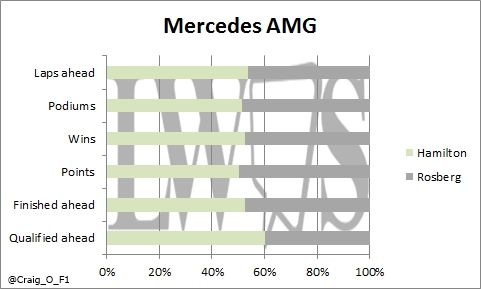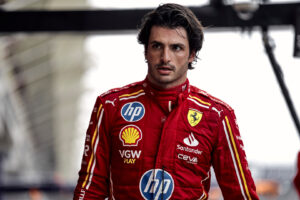Drivers: Nico Rosberg – 1st, 385 points; Lewis Hamilton – 2nd, 380 points
Best grid position: 1st – Hamilton, Australia, Bahrain, Spain, Canada, Austria, Britain, Italy, Malaysia, United States, Mexico, Brazil, Abu Dhabi; Rosberg, China, Russia, Azerbaijan, Hungary, Germany, Belgium, Singapore, Japan
Best race result: 1st –Hamilton, Monaco, Canada, Austria, Britain, Hungary, Germany, United States, Mexico, Brazil, Abu Dhabi; Rosberg, Australia, Bahrain, China, Russia, Azerbaijan, Belgium, Italy, Singapore, Japan
2016 World Constructors Championship Position (2015, 2014): 1st (1st, 1st)

2014 and 2015 were nothing more than demonstrations of driving and manufacturing excellence from Mercedes, as they realised the potential of the hard work put in over the four seasons previous. However, as was the case with so many periods of dominance before them – arguably none as strong as this, many wanted something new for 2016. People wanted someone to take the fight to Mercedes, and for a while, it looked as if they had to work hard to retain their titles.
Mercedes F1 2016 Review
Pre-season testing did not provide much cause for optimism within the neutral fans, as Mercedes would be beyond impressive, and seemingly bulletproof. A 1-2 on the grid at Australia also did not do much to ease those bored of dominance, but things took a sharp twist come race day. Sebastian Vettel, Kimi Raikkonen and Ferrari left Mercedes for dust at the start, and looked set to take a brilliant 1-2 of their own, until strategy and reliability greatly hindered the Scuderia. It would be Rosberg – continuing his streak of race wins from 2015, who would lead his team mate Hamilton home on that occasion.
Not getting away well would appear to be one of Mercedes’ downfalls early in the season. Bahrain only resulted in a 1-3 for the team after Hamilton was hit by Valtteri Bottas at the start. China saw Rosberg lose the lead at the start, whilst Hamilton was hampered by a multitude of problems including failing to set a qualifying time after an engine failure and contact at the start.
Russia would see Hamilton hampered again by reliability issues whilst Rosberg would leave the chaos behind him to cruise to an easy win. Spain would see both Mercedes make it no further than the first four corners after what was a collision which divided even World Champions. Ultimately it was seen as nothing more than a racing incident.
Monaco would see the first real swing in momentum between the two Mercedes drivers, where Rosberg had to let Hamilton through after failing to get any tyre or brake temperature into his car. The points leader would suffer a woeful performance whilst Hamilton would inherit the win after a catastrophic Red Bull mistake.
Hamilton would win six races from seven, and fail to win at Azerbaijan after crashing out in qualifying. However Rosberg would suffer a puncture and a spin at Canada, a collision and a gearbox problem at Austria, another gearbox problem at Silverstone, and slow starts at Hungary and Germany. Rosberg was also penalised controversially at Germany, whilst he was spared sanction at Hungary, again controversially.
At this point of the season, it became evidently clear that Ferrari were no longer the key challengers to Mercedes, but Red Bull were. Hamilton’s engine problems at the start of the year came back to haunt him after the summer break, but he was able to stockpile power units through a loophole in the regulations (which will be closed for 2017). Thanks to a red flag (again, closed for 2017), he was able to make up a lot of ground to minimalize the damage at Belgium.
Italy would see Hamilton hampered by another slow start, despite emphatically beating Rosberg up until that point of the weekend. Meanwhile Singapore would see Hamilton uncharacteristically well off the pace, as Rosberg would brilliantly hold off a charging Daniel Ricciardo. At this point, Hamilton looked as if he needed a bit of luck and an upturn in form to overhaul Rosberg, whilst Mercedes looked more than set to retain their Constructors’ Championship.
It was all looking good for Hamilton at Malaysia – leading comfortably at the front, whilst Rosberg had to recover after being hit by Vettel at the start. Then Hamilton’s engine blew. It would be Mercedes’ only mechanical retirement from a race in the season. Rosberg, however, would brilliantly recover to third place behind the two Red Bulls.
Japan would be another poor start from Hamilton, whilst Rosberg won, after a very tight battle in qualifying. At this point, it was out of Hamilton’s hands, and he needed Rosberg to finish a few races below second place.
Hamilton brilliantly won at Texas, Mexico, and more crucially, in the rain at Interlagos. However Rosberg would be on his tail on each occasion. Hamilton’s start antics at Mexico came under scrutiny, but rightly, was not penalised. Hamilton did all he could, including disobey team orders, to try and take the championship into his own hands, but it was not possible for him. He led Rosberg home to a 1-2 at Abu Dhabi but the damage was already done, and his team mate took his first World Championship.
2017 is where Mercedes are most likely to date to be challenged for Formula One’s crowns. The massive changes to the cars are expected to suit Red Bull more than anybody else, and they finished the season very well. Their Trump Card in the incredible power unit is becoming less and less effective, as Renault, Ferrari and Honda continue to converge towards the benchmark in terms of engineering excellence in Formula One.
Main Photo






